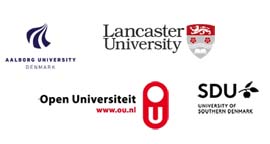

Designing for Dialogue and Digitality in Higher and Continuing Education
Elsebeth Korsgaard Sorensen, Aalborg University, Aalborg, Denmark. Thomas Kjærgaard, Aalborg University & University College North, Aalborg, Denmark
This study investigates and contrasts three scenarios of further education; presence lessons and two types of blended learning. It addresses the conceptual challenge of creating learning designs for online learning communities of practice (COPs) with a focus on 'collaborative digital dialogue as the curriculum' (CDDC). The aim of the study is to identify the mechanisms that spawn and maintain collaboration and dialogue in digital/online discussions. Emphasis is put on locating the essential pedagogic-didactic elements giving rise to peer-to-peer dialogue, collaborative knowledge building (CKB) and reflection. As a basis for exploring, identifying, assessing and discussing pertinent elements in pedagogic design of online learning in COPs, we apply as the analytical optic a framework of Critical Realism (CR). In exploring the notion ‘nexus of cognition' (NOC) and the emergence of an ‘open source learning stream' (OSLS) in digital dialogue (DD), unfolding in virtual learning environments (VLEs), the paper further investigates the appropriateness in this respect of diverse scaffolding mechanisms, reaching from phatic teacher comments to academic, scaffolding video-clips. The empirical basis for studying these design aspects is constituted by learning designs from, both a University context and a University College context. The findings and discussion resulting from the analysis suggest that a meta-communicative learning-to-learn (L2L) approach to dialogue in the pedagogic aspects of the learning design may be fruitful in highlighting and promoting the establishment and maintenance of a collaborative digital dialogue that is conducive to deep learning in digital CoPs unfolding in VLEs. Consequently, we suggest development of hybrid designs that synthesise the dialogical advantages of online dialogue, the convenience of teacher-produced videos and the intensity of being together in actual reality.
We acknowledge the deleuzean point that the virtual is just as real as the actual and in this context the virtual is even more real than the actual. The online dialogue becomes 'a pure place' while the conversation in the presence lesson becomes 'polluted'. The online dialogue achieves a virtual purity of 'one discourse' whereas the presence lesson contains multiple discourse of which some are relevant to the learning process and other have a more private character. We promote a hybrid design that put the students in the centre of the dialogue, which means that only when they engage in the dialogue will they be engaged in learning.
Keywords
Learning Design (LD), Collaborative Knowledge Building (CKB), Digital Dialogue (DD), Dialogue as the Curriculum (DC), Open Source Learning Stream (OSLS), Dialogue and Digitality (DD), Nexus of Cognition (NOC), Communities of Practice (CoPs)
Joint Organising Institutions
| Past Conference Proceedings |Call for Book Proposals| Contact |